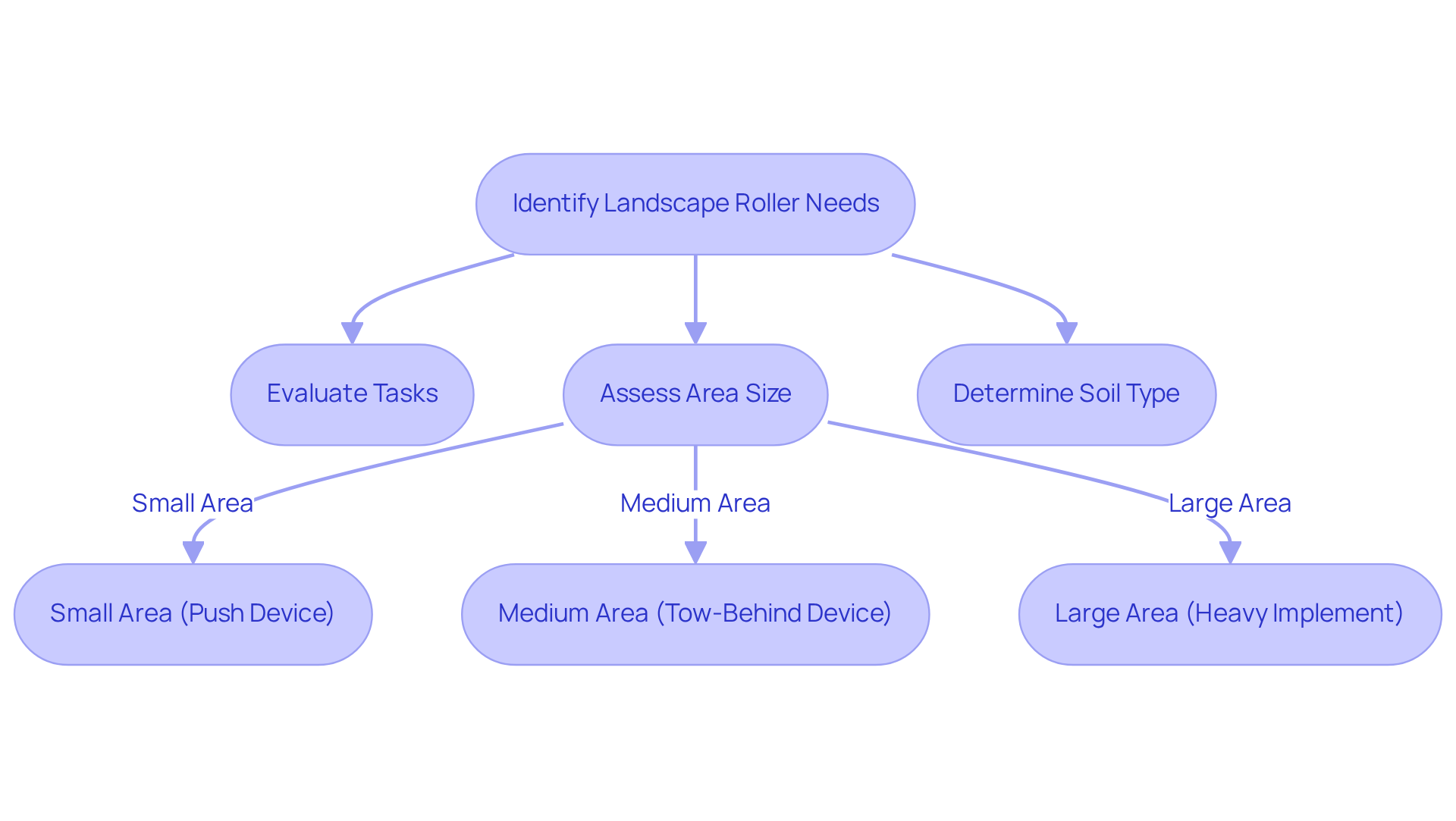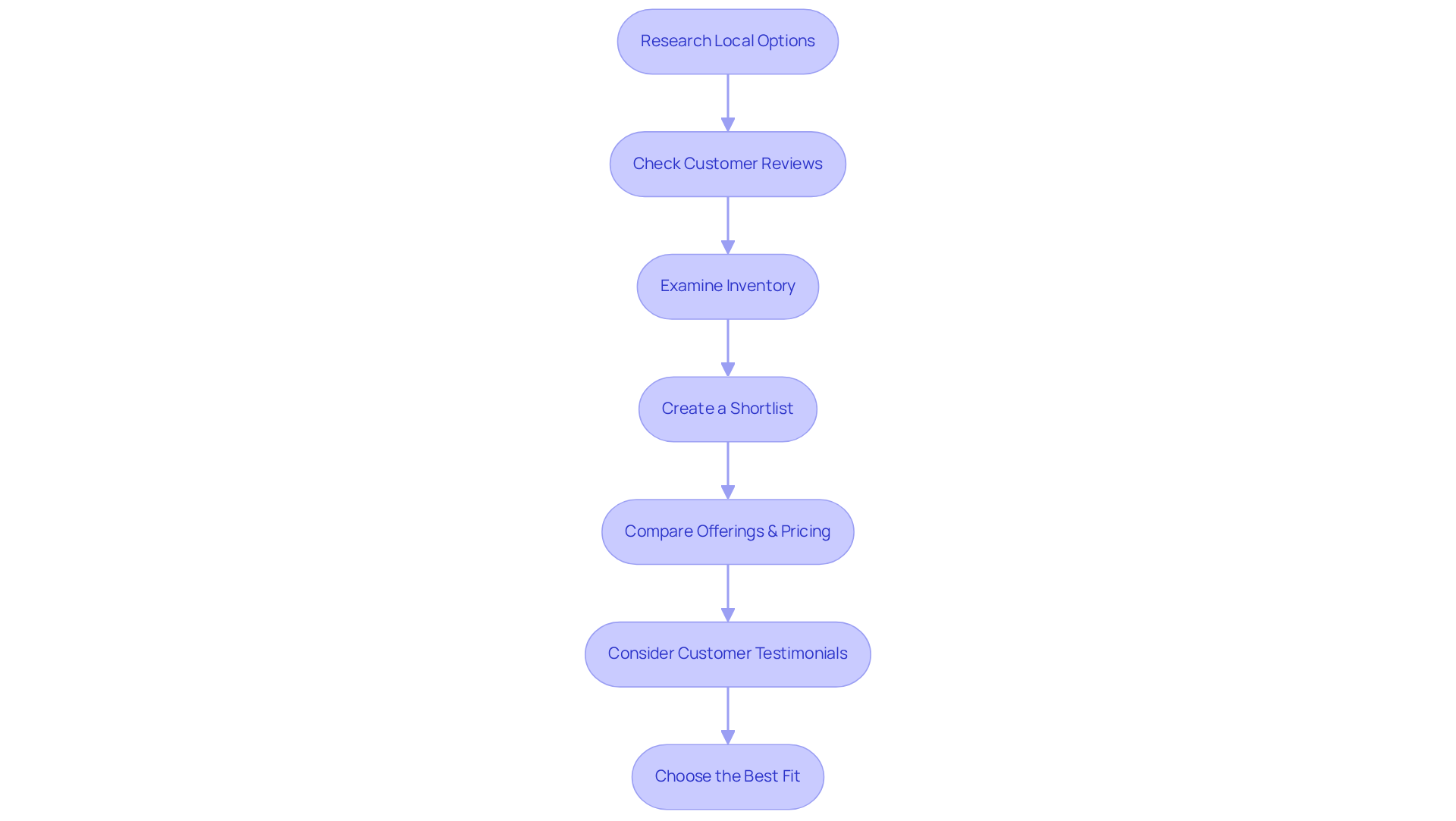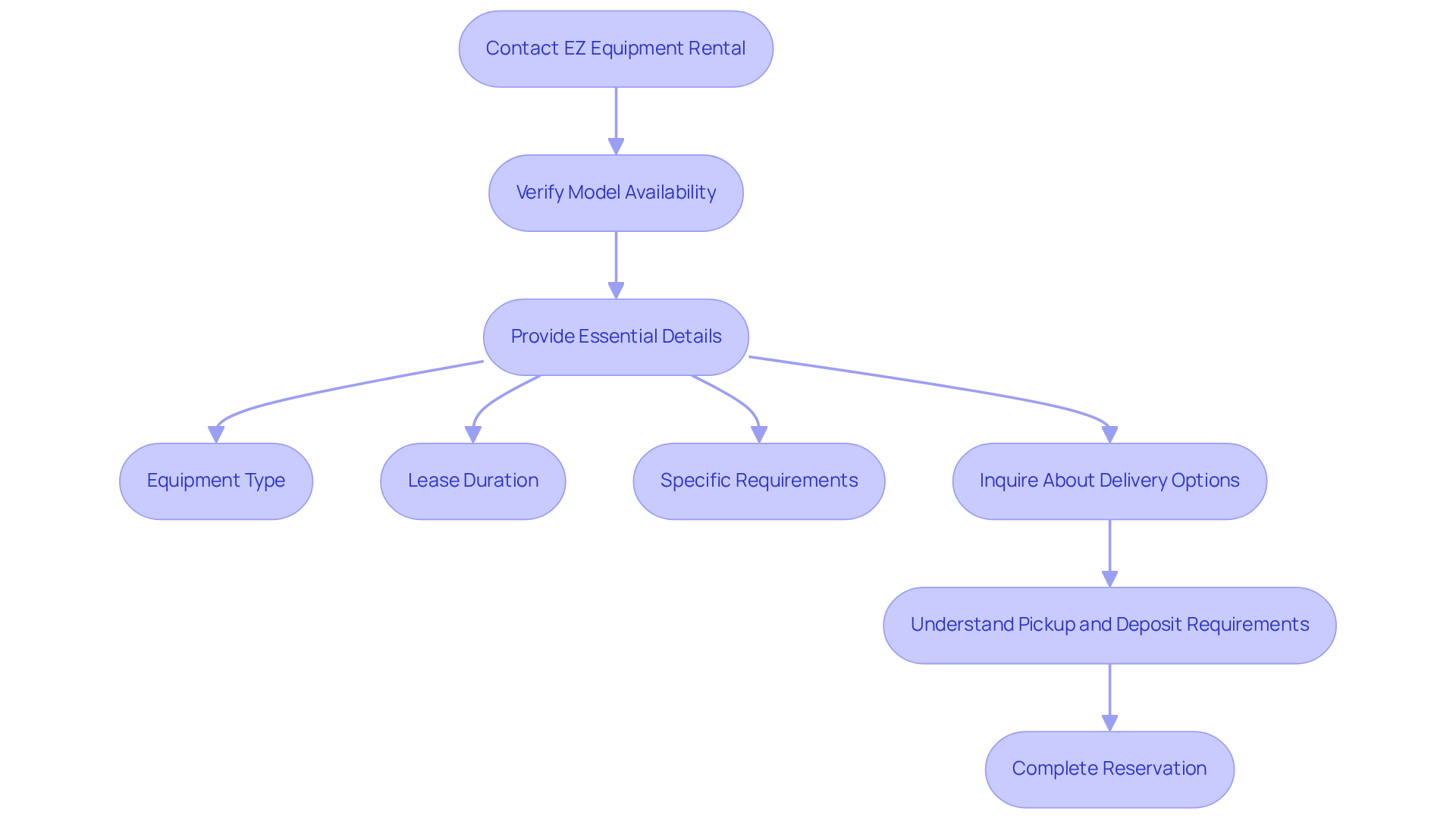Overview
Successfully renting a landscape roller involves four essential steps:
- Identify your specific needs based on area size and soil type.
- Research local rental services to find the best options available.
- Reserve the appropriate equipment that meets your requirements.
- Prepare for pickup to ensure a seamless experience.
Careful evaluation of project requirements and thorough comparison of rental options, such as EZ Equipment Rental, guarantees a smooth rental process and enhances the efficiency of your landscaping tasks.
Key Highlights:
- Evaluate specific landscaping tasks to select the appropriate landscape roller based on area size and soil type.
- For large areas, a heavier roller is recommended; for smaller areas, a push device may suffice.
- Consider the weight capacity and dimensions of the roller; a 36-inch wide device is ideal for levelling uneven lawns.
- Research local equipment rental services with strong customer reviews to find reliable options.
- EZ Equipment Rental is highlighted as a reputable provider in the Dallas-Fort Worth area, offering various landscape roller rental options.
- Create a shortlist of rental services, comparing their offerings, pricing, and customer testimonials.
- To reserve a landscape roller, verify availability with the rental company and provide necessary details, including equipment type and lease duration.
- Ensure you have all required documentation and verify your vehicle can accommodate the equipment before pickup.
- Create a secure storage area for the equipment to prevent injuries and reduce maintenance costs.
Introduction
Selecting the right landscape roller is pivotal to the success of any landscaping project. However, many individuals find themselves overwhelmed by the myriad of options available. This guide streamlines the rental process by detailing four essential steps that guarantee a successful experience, from identifying specific needs to preparing for equipment pickup.
What are the consequences of making the wrong choice? Inefficiency and frustration can easily arise, undermining even the best-laid plans.
Learn how to navigate the landscape roller rental landscape effectively and sidestep common pitfalls.
Identify Your Landscape Roller Needs
To effectively select the appropriate landscape tool for your undertaking, begin by evaluating the specific tasks at hand. Assess the size of the area you will be working on and the type of soil or grass involved. For instance, when leveling a large lawn or preparing a seedbed, opting for a heavier implement ensures adequate compaction. Conversely, if your project encompasses smaller areas, a push device may suffice, while a tow-behind apparatus is more suitable for expansive spaces.
Consider the weight capacity and dimensions of the device as you compile your requirements. For example, if you are managing a 1,000 square foot lawn with uneven areas, a 36-inch wide device filled with water is ideal for leveling the surface efficiently without compromising soil compaction.
Landscaping experts emphasize the importance of aligning the type of equipment with the specific requirements of your task. They recommend taking into account the average dimensions of regions needing landscape equipment, alongside the distinct features of the soil. Successful projects often highlight the advantages of selecting the correct machinery, demonstrating how a landscape roller rental can lead to improved outcomes and enhanced efficiency in landscaping activities.

Research Local Equipment Rental Services
Begin your search for equipment leasing services by exploring local options that specialize in landscaping tools, such as landscape roller rental. It is essential to prioritize companies with strong customer reviews and ratings, as these insights can significantly inform you about their reliability and service quality. Ensure that the leasing company has the specific landscape roller rental equipment you require by thoroughly examining their inventory. EZ Equipment Rental is a standout in the Dallas-Fort Worth area, boasting an extensive selection and a firm commitment to customer satisfaction.
Create a shortlist of potential leasing services, comparing their offerings, pricing, and terms to identify the best fit for your project needs. For instance, EZ Equipment Rental provides a variety of landscape roller rental options, including both push and tow-behind compaction machines, with flexible leasing conditions tailored to your schedule. This adaptability not only meets your immediate requirements but also enhances your project's efficiency.
In addition, consider the testimonials from satisfied customers who have experienced the reliability and quality of service firsthand. Their positive feedback reinforces the credibility of these companies and can guide your decision-making process. By taking these steps, you will ensure that you choose a leasing service that not only meets your equipment needs but also aligns with your expectations for quality and service.

Reserve Your Landscape Roller
To book a landscape compactor, begin by verifying the availability of your preferred model with EZ Equipment Rental, a trusted source for equipment leases in Irving, TX, serving the DFW Metroplex. Contact the company directly at (214) 951-7800 or visit their website to initiate your reservation. Be prepared to provide essential details, such as the type of equipment you need, the duration of the lease, and any specific requirements you may have. Additionally, inquire about delivery options, leasing agreements, and any extra charges that might apply.
For example, when renting from EZ Equipment Rental, you could specify a 36-inch tow-behind roller for a weekend project. Understanding the pickup time and any required deposits is vital to ensure a seamless borrowing experience. EZ Equipment Rental operates Monday to Friday from 7:30 AM to 5:30 PM and Saturday from 7:30 AM to 5:00 PM, making it convenient for your scheduling needs.
Regarding efficiency, the average time to reserve equipment in the leasing market can vary. However, many companies strive to streamline the process, often allowing reservations to be completed within minutes online or over the phone. According to industry insights, the construction equipment leasing market is projected to expand at a CAGR of 6.6% from 2023 to 2032, highlighting the increasing demand for leasing services.
Case studies indicate that clear communication during the reservation process can significantly enhance customer satisfaction. As noted by leasing service experts, "Verifying all details in the leasing contract is crucial to prevent misunderstandings and ensure that all parties are aligned on expectations." It is advisable to maintain a record of your lease agreement for future reference.

Prepare for Equipment Pickup
Before you set out to collect your landscape equipment, ensure you have all necessary documentation, including your rental agreement and identification. It's crucial to check your vehicle to confirm it can accommodate the size and weight of the equipment. If you are renting a tow-behind compactor, verify that your towing vehicle is equipped and capable of handling the load. For example:
- The 2025 GMC Sierra 1500 can tow up to 13,200 pounds
- The 2025 Ram 1500 up to 11,550 pounds
- The 2025 Toyota Tundra up to 12,000 pounds
This provides a range of options for your towing needs. Furthermore, create a secure area at your residence or work site for the roller when it is not in use. Proper storage is essential to prevent injuries and reduce maintenance costs. This preparation will facilitate a smooth pickup and ensure you are ready to commence your landscaping project with the landscape roller rental without delays. As noted by industry professionals, planning and analytics are vital for effective equipment management, so be sure to consider all aspects of your rental process.

Conclusion
Understanding the process of successfully renting a landscape roller is vital for achieving optimal results in landscaping projects. By carefully assessing specific needs, researching local rental services, reserving the right equipment, and preparing for pickup, individuals can ensure a smooth and efficient experience. This comprehensive approach not only enhances the effectiveness of the rental process but also significantly contributes to the overall success of the landscaping endeavor.
Key insights from this guide emphasize the importance of:
- Matching the landscape roller to project requirements
- Selecting reputable rental services
- Maintaining clear communication throughout the reservation process
Furthermore, being well-prepared for equipment pickup can prevent potential issues and streamline the entire operation. Each step plays a crucial role in maximizing productivity and ensuring that the chosen equipment meets the demands of the task at hand.
Ultimately, taking the time to follow these steps can lead to a more rewarding landscaping experience. Whether a homeowner tackling a small lawn or a professional managing larger projects, understanding how to navigate the landscape roller rental process is invaluable. Embracing these guidelines not only facilitates effective equipment use but also enhances the quality of landscaping results, paving the way for future success in outdoor projects.
Frequently Asked Questions
How do I determine my landscape roller needs?
To determine your landscape roller needs, evaluate the specific tasks at hand, including the size of the area and the type of soil or grass involved.
What should I consider when selecting a landscape roller?
Consider the weight capacity and dimensions of the device, as well as the specific requirements of your project, such as whether you need to level a large lawn or prepare a seedbed.
What type of landscape roller is suitable for a large area?
For expansive spaces, a tow-behind apparatus is more suitable, as it can handle larger areas effectively.
What type of landscape roller works best for smaller areas?
A push device may suffice for smaller areas, providing adequate compaction without the need for larger equipment.
What are the benefits of using a heavier landscape roller?
A heavier implement ensures adequate compaction, which is particularly important when leveling large lawns or preparing seedbeds.
What is an ideal landscape roller for managing a 1,000 square foot lawn?
A 36-inch wide device filled with water is ideal for leveling a 1,000 square foot lawn with uneven areas efficiently without compromising soil compaction.
Why is it important to align the type of equipment with my landscaping needs?
Aligning the type of equipment with your specific requirements leads to improved outcomes and enhanced efficiency in landscaping activities.




